1-(3-Bromopropoxy)-4-nitrobenzene
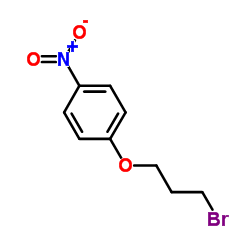
1-(3-Bromopropoxy)-4-nitrobenzene structure
|
Common Name | 1-(3-Bromopropoxy)-4-nitrobenzene | ||
|---|---|---|---|---|
| CAS Number | 13094-50-3 | Molecular Weight | 260.085 | |
| Density | 1.5±0.1 g/cm3 | Boiling Point | 373.3±22.0 °C at 760 mmHg | |
| Molecular Formula | C9H10BrNO3 | Melting Point | 56-58ºC | |
| MSDS | N/A | Flash Point | 179.6±22.3 °C | |
| Name | 1-(3-bromopropoxy)-4-nitrobenzene |
|---|---|
| Synonym | More Synonyms |
| Density | 1.5±0.1 g/cm3 |
|---|---|
| Boiling Point | 373.3±22.0 °C at 760 mmHg |
| Melting Point | 56-58ºC |
| Molecular Formula | C9H10BrNO3 |
| Molecular Weight | 260.085 |
| Flash Point | 179.6±22.3 °C |
| Exact Mass | 258.984406 |
| PSA | 55.05000 |
| LogP | 3.19 |
| Vapour Pressure | 0.0±0.8 mmHg at 25°C |
| Index of Refraction | 1.573 |
| InChIKey | LIBYGKUWXRBMPA-UHFFFAOYSA-N |
| SMILES | O=[N+]([O-])c1ccc(OCCCBr)cc1 |
Synonym: Section 2 - COMPOSITION, INFORMATION ON INGREDIENTS
Risk Phrases: 36/37/38 Section 3 - HAZARDS IDENTIFICATION EMERGENCY OVERVIEW
Irritating to eyes, respiratory system and skin. Potential Health Effects Eye: Causes eye irritation. Lachrymator (substance which increases the flow of tears). Skin: Causes skin irritation. Ingestion: May cause irritation of the digestive tract. The toxicological properties of this substance have not been fully investigated. Inhalation: Causes respiratory tract irritation. Chronic: Not available. Section 4 - FIRST AID MEASURES Eyes: Flush eyes with plenty of water for at least 15 minutes, occasionally lifting the upper and lower eyelids. Get medical aid. Skin: Get medical aid. Flush skin with plenty of water for at least 15 minutes while removing contaminated clothing and shoes. Ingestion: Get medical aid. Wash mouth out with water. Inhalation: Remove from exposure and move to fresh air immediately. If not breathing, give artificial respiration. If breathing is difficult, give oxygen. Get medical aid. Notes to Physician: Section 5 - FIRE FIGHTING MEASURES General Information: As in any fire, wear a self-contained breathing apparatus in pressure-demand, MSHA/NIOSH (approved or equivalent), and full protective gear. Extinguishing Media: Use foam, dry chemical, or carbon dioxide. Section 6 - ACCIDENTAL RELEASE MEASURES General Information: Use proper personal protective equipment as indicated in Section 8. Spills/Leaks: Vacuum or sweep up material and place into a suitable disposal container. Section 7 - HANDLING and STORAGE Handling: Avoid breathing dust, vapor, mist, or gas. Avoid contact with skin and eyes. Storage: Store in a cool, dry place. Store in a tightly closed container. Section 8 - EXPOSURE CONTROLS, PERSONAL PROTECTION Engineering Controls: Use adequate ventilation to keep airborne concentrations low. Exposure Limits CAS# 13094-50-3: Personal Protective Equipment Eyes: Not available. Skin: Wear appropriate protective gloves to prevent skin exposure. Clothing: Wear appropriate protective clothing to prevent skin exposure. Respirators: Follow the OSHA respirator regulations found in 29 CFR 1910.134 or European Standard EN 149. Use a NIOSH/MSHA or European Standard EN 149 approved respirator if exposure limits are exceeded or if irritation or other symptoms are experienced. Section 9 - PHYSICAL AND CHEMICAL PROPERTIES Physical State: Solid Color: Not available. Odor: Not available. pH: Not available. Vapor Pressure: Not available. Viscosity: Not available. Boiling Point: Not available. Freezing/Melting Point: 56 - 58 deg C Autoignition Temperature: Not available. Flash Point: Not available. Explosion Limits, lower: Not available. Explosion Limits, upper: Not available. Decomposition Temperature: Solubility in water: Specific Gravity/Density: Molecular Formula: NO2C6H4O(CH2)3Br Molecular Weight: 260.09 Section 10 - STABILITY AND REACTIVITY Chemical Stability: Not available. Conditions to Avoid: Incompatible materials. Incompatibilities with Other Materials: Not available. Hazardous Decomposition Products: Carbon monoxide, carbon dioxide. Hazardous Polymerization: Not available. Section 11 - TOXICOLOGICAL INFORMATION RTECS#: CAS# 13094-50-3 unlisted. LD50/LC50: Not available. Carcinogenicity: 1-(5-Bromopropoxy)-4-nitrobenzene - Not listed by ACGIH, IARC, or NTP. Section 12 - ECOLOGICAL INFORMATION Section 13 - DISPOSAL CONSIDERATIONS Dispose of in a manner consistent with federal, state, and local regulations. Section 14 - TRANSPORT INFORMATION IATA Not regulated as a hazardous material. IMO Not regulated as a hazardous material. RID/ADR Not regulated as a hazardous material. Section 15 - REGULATORY INFORMATION European/International Regulations European Labeling in Accordance with EC Directives Hazard Symbols: XI Risk Phrases: R 36/37/38 Irritating to eyes, respiratory system and skin. Safety Phrases: S 26 In case of contact with eyes, rinse immediately with plenty of water and seek medical advice. S 37/39 Wear suitable gloves and eye/face protection. WGK (Water Danger/Protection) CAS# 13094-50-3: No information available. Canada None of the chemicals in this product are listed on the DSL/NDSL list. CAS# 13094-50-3 is not listed on Canada's Ingredient Disclosure List. US FEDERAL TSCA CAS# 13094-50-3 is not listed on the TSCA inventory. It is for research and development use only. SECTION 16 - ADDITIONAL INFORMATION N/A |
| Hazard Codes | Xn: Harmful;Xi: Irritant; |
|---|---|
| Risk Phrases | R36/37/38 |
| Safety Phrases | 36/37/39-26-22 |
| HS Code | 2909309090 |
|
~76% 
1-(3-Bromopropo... CAS#:13094-50-3 |
| Literature: Song, Hyeseung; Lee, Yun Suk; Roh, Eun Joo; Seo, Jae Hong; Oh, Kwang-Seok; Lee, Byung Ho; Han, Hogyu; Shin, Kye Jung Bioorganic and Medicinal Chemistry Letters, 2012 , vol. 22, # 17 p. 5668 - 5674 |
|
~76% 
1-(3-Bromopropo... CAS#:13094-50-3 |
| Literature: Ghosh, Raju; Lindstedt, Erik; Jalalian, Nazli; Olofsson, Berit ChemistryOpen, 2014 , vol. 3, # 2 p. 54 - 57 |
|
~61% 
1-(3-Bromopropo... CAS#:13094-50-3 |
| Literature: Jin, Yi; Zhou, Zu-Yu; Tian, Wei; Yu, Qiang; Long, Ya-Qiu Bioorganic and Medicinal Chemistry Letters, 2006 , vol. 16, # 22 p. 5864 - 5869 |
|
~% 
1-(3-Bromopropo... CAS#:13094-50-3 |
| Literature: Synthesis, , # 11 p. 1069 - 1071 |
|
~% 
1-(3-Bromopropo... CAS#:13094-50-3 |
| Literature: Bioorganic and Medicinal Chemistry Letters, , vol. 16, # 22 p. 5864 - 5869 |
|
~% 
1-(3-Bromopropo... CAS#:13094-50-3 |
| Literature: Journal of Pharmaceutical Sciences, , vol. 56, p. 380 - 384 |
|
~% 
1-(3-Bromopropo... CAS#:13094-50-3 |
| Literature: Journal of the Chemical Society, , p. 3298,3308 |
| Precursor 8 | |
|---|---|
| DownStream 9 | |
| HS Code | 2909309090 |
|---|---|
| Summary | 2909309090 other aromatic ethers and their halogenated, sulphonated, nitrated or nitrosated derivatives VAT:17.0% Tax rebate rate:9.0% Supervision conditions:none MFN tariff:5.5% General tariff:30.0% |
| 4-(3-bromopropoxy)-nitrobenzene |
| 1-(3-Bromopropoxy)-4-nitrobenzene |
| Benzene, 1-(3-bromopropoxy)-4-nitro- |
| 1-bromo-3-(4-nitrophenoxy)propane |
| 3-(4-nitrophenoxy)propyl bromide |
| (3-bromo-propyl)-(4-nitro-phenyl)-ether |
| 1-(3-bromopropyloxy)-4-nitrobenzene |
| 3-Bromopropyl 4-nitrophenyl ether |
| (3-Brom-propyl)-(4-nitro-phenyl)-aether |
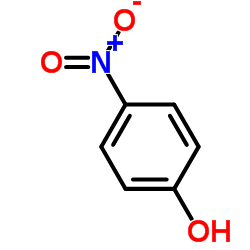
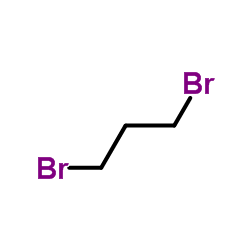



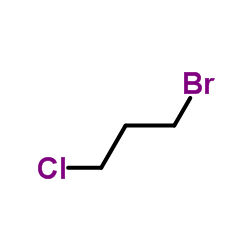
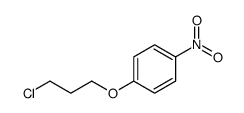
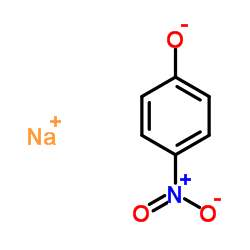
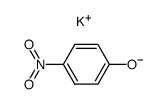
![4-[3-(4-nitrophenoxy)propoxy]benzonitrile structure](https://image.chemsrc.com/caspic/344/18167-27-6.png) CAS#:18167-27-6
CAS#:18167-27-6![4-[3-(4-methylpiperazin-1-yl)propoxy]aniline structure](https://image.chemsrc.com/caspic/232/220822-26-4.png) CAS#:220822-26-4
CAS#:220822-26-4 CAS#:103797-32-6
CAS#:103797-32-6![Acetamide,N-[4-[3-(4-nitrophenoxy)propoxy]phenyl]- structure](https://image.chemsrc.com/caspic/229/31066-21-4.png) CAS#:31066-21-4
CAS#:31066-21-4 CAS#:343965-79-7
CAS#:343965-79-7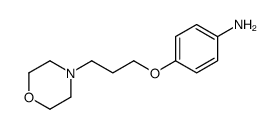 CAS#:100800-40-6
CAS#:100800-40-6![1-[3-(4-nitrophenoxy)propyl]imidazole structure](https://image.chemsrc.com/caspic/113/88138-61-8.png) CAS#:88138-61-8
CAS#:88138-61-8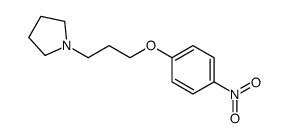 CAS#:92033-81-3
CAS#:92033-81-3![1-[3-(4-nitrophenoxy)propyl]piperidine structure](https://image.chemsrc.com/caspic/128/92374-75-9.png) CAS#:92374-75-9
CAS#:92374-75-9